We’ve previously explained why businesses should shift to sustainable packaging. In short, scientists are providing more and more evidence that humanity as a whole needs to shift to more sustainable means of packaging in order to protect the environment. This has caused a social shift whereby customers expect businesses to be socially responsible and care for the environment. More and more customers want to support businesses who strive towards sustainability and they want to avoid businesses who do the opposite. Many businesses have woken up to this fact and they have now incorporated sustainability into their strategic goals.
With that said, what kinds of new and interesting trends can we find in the sustainable packaging space?
Biodegradable Peanuts
Packing peanuts, also known as foam peanuts or foam popcorn or packing noodles is used to fill packages to protect sensitive products. Packing peanuts have traditionally been made from Styrofoam, which is a plastic polymer otherwise known as EPS (expanded polystyrene). Plastics like EPS that take around 500 years to degrade can stay in the environment for a long time and cause problems. Due to how small they are, it is also very easy for them to be blown into the sea. A couple of cities have already banned their usage.
That’s where biodegradable packing peanuts come in. They are usually made from wheat or starch and only take a few months to degrade. Typically biodegradable packing peanuts are made from recycled material and can be used as compost after they are used. Unfortunately, they need to be disposed of properly or else they don’t degrade as fast. Lots of oxygen and light is important. Additionally, they tend to have a higher density and weight and so can possibly raise shipping costs.
Cardboard Bubble Wrap
That’s right. We’re all familiar with plastic bubble wrap. Now, what if we swapped the plastic for cardboard instead? Cardboard bubble wrap uses corrugated cardboard that is cut in such a way that it can expand and contract like an accordion. This kind of cardboard can mimic the properties of bubble wrap to keep products safe by acting as a soft cushioning. For now plastic bubble wrap has the advantage of being able to wrap various different shapes. Cardboard doesn’t have as much versatility yet. That is sure to change.
Edible Packaging
There is nothing more biodegradable than food. That’s what makes edible packaging a great take on sustainable packaging. It’s perfect for packaging food. Most commonly, seaweed is used to make these kinds of packaging. Evoware has done this in Indonesia where instead of burgers being wrapped in plastic or paper, they are wrapped in something made out of seaweed. For those who may not particularly like the taste of seaweed, tasteless variations of this kind of sustainable edible packaging is already available.
Ooho is a biodegradable plastic made from seaweed and other plants. It was used in the 2019 London Marathon where it replaced traditional plastic bottles. These Ooho pouches contained water and/or energy drinks. All you had to do was bite into it to quench your thirst. If you did not want to eat the pouch itself, you were welcome to throw it away instead. It would degrade in about 6 months. That’s a big step up from the usual time-frame of centuries!











